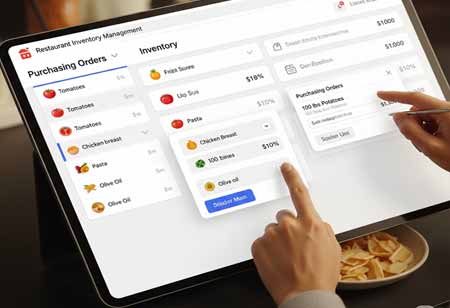THANK YOU FOR SUBSCRIBING
Be first to read the latest tech news, Industry Leader's Insights, and CIO interviews of medium and large enterprises exclusively from Food and Beverage Tech Review
The Inventory Evolution Behind the Bar and Kitchen
Inventory management in restaurants and bars has transformed from manual processes to automated, data-driven systems, enhancing efficiency, profitability, and guest satisfaction through real-time tracking and analytics.

By
Food and Beverages Tech Review | Thursday, September 04, 2025
Stay ahead of the industry with exclusive feature stories on the top companies, expert insights and the latest news delivered straight to your inbox. Subscribe today.
The restaurant and bar industry has performed well in terms of efficiency, and at the heart of this efficiency lies a remarkable transformation in inventory management. What was once a laborious, manual process involving clipboards and guesswork has evolved into a highly automated, data-driven discipline, primarily due to the development of purpose-built software solutions. This evolution has not only streamlined operations but has fundamentally reshaped how hospitality businesses approach profitability and guest satisfaction.
Managing inventory in a restaurant or bar was a significant challenge. Physical counts were sporadic, often inaccurate, and prone to human error. Ordering decisions were frequently based on intuition or rough estimates, resulting in either excessive waste from overstocking or missed sales opportunities due to stockouts. This lack of precise control directly impacted the bottom line, making it challenging to understand actual costs and identify areas for improvement.
The advent of specialized inventory management software marked a significant turning point in the field. Early iterations focused on basic digital record-keeping, moving away from paper logs to spreadsheets and simple databases. This provided a foundational level of organization, allowing for more consistent tracking. However, these systems still required significant manual input and lacked the real-time capabilities that define modern solutions.
Core Functionalities Redefining Operations
Today's restaurant and bar inventory management software is a comprehensive ecosystem designed to optimize every facet of stock control. A core feature is real-time inventory tracking. This allows operators to know precisely what they have on hand at any given moment. Through seamless integration with Point-of-Sale (POS) systems, items are automatically deducted from inventory as they're sold. This eliminates the need for manual updates, providing an immediate and accurate picture of stock levels. The ability to monitor inventory in real-time is crucial for avoiding unexpected shortages, especially during peak service hours, and for making agile decisions about menu availability.
Beyond mere tracking, these systems provide advanced integration for ordering and purchasing. Based on consumption patterns and predefined minimum stock levels (often referred to as "par levels"), the software can generate suggestive reorder lists or even automate purchase orders directly with suppliers. This intelligent automation removes the guesswork from replenishment, ensuring that necessary ingredients and beverages are always available without tying up excessive capital in overstocked items. Some systems also include features for managing supplier relationships, centralizing invoices, and tracking pricing variations, allowing for more strategic procurement.
Recipe management and costing are integral components of modern inventory software. By meticulously detailing the ingredients and quantities required for each menu item, the system can accurately calculate the theoretical cost of every dish or drink. This empowers operators, giving them a sense of control and confidence to make informed decisions about menu pricing, identify profitable items, and pinpoint areas where ingredient costs might be disproportionately high. When combined with real-time inventory usage data, this feature provides invaluable insights into actual versus theoretical usage, highlighting potential discrepancies due to waste, spillage, or portion control issues.
Data-Driven Insights and Accessibility
The analytical capabilities of contemporary inventory software are profound. Data analytics and reporting tools transform raw inventory data into actionable insights. Operators can generate reports on sales trends, ingredient consumption, waste percentages, and profitability by category or individual item. This historical data is then leveraged for predictive analytics, with advanced algorithms anticipating future demand based on seasonality, promotions, and past sales performance. This foresight enables highly accurate forecasting, leading to optimized ordering, reduced spoilage, and improved overall financial performance.
For businesses with multiple locations, multi-location management features are indispensable. Centralized dashboards offer a comprehensive view of inventory across all establishments, enabling efficient stock transfers, standardized ordering processes, and consistent menu offerings. This ensures uniformity in operations and empowers management to identify and address inconsistencies across their portfolio.
The contemporary landscape also emphasizes mobile accessibility. Many solutions offer dedicated mobile applications, allowing staff to conduct inventory counts, receive deliveries, and check stock levels using handheld devices or even their smartphones. Features like barcode scanning or QR code integration further enhance accuracy and speed during physical inventory processes. This mobile flexibility significantly reduces the time and labor associated with traditional inventory tasks, freeing up staff to focus on guest service.
The Future of Inventory Management
Looking ahead, the trajectory of restaurant and bar inventory management software is one of increasing sophistication and integration. The continued rise of cloud-based solutions provides unparalleled accessibility, scalability, and data security. The infusion of Artificial Intelligence (AI) and Machine Learning (ML) is making systems even smarter, moving beyond predictive analytics to intelligent automation, where systems can learn and adapt to business conditions with minimal human intervention. The emphasis on sustainability is driving features that help businesses minimize food waste and optimize resource utilization, aligning with growing consumer and industry demands for environmentally conscious practices.
Restaurant and bar inventory management software has evolved from a simple tracking tool to a strategic asset. It underpins operational efficiency, enhances profitability, and plays a vital role in delivering a consistent and high-quality experience for patrons. As the hospitality industry continues to embrace digital transformation, these sophisticated systems will remain at the forefront, driving smarter decisions and fostering greater success.
I agree We use cookies on this website to enhance your user experience. By clicking any link on this page you are giving your consent for us to set cookies. More info







